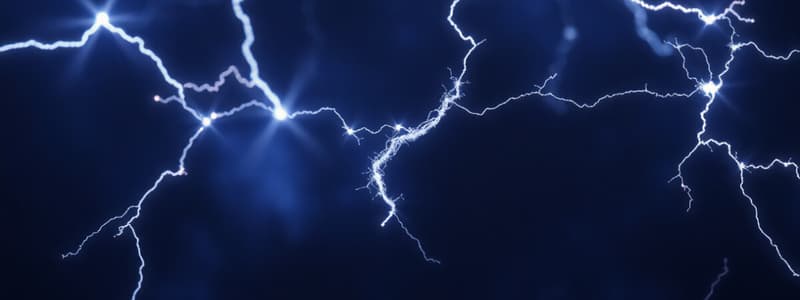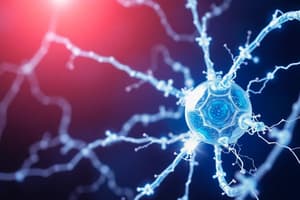Podcast
Questions and Answers
What happens to a positively charged object when it is grounded?
What happens to a positively charged object when it is grounded?
- It retains its charge
- It loses electrons to the ground
- It gains electrons from the ground (correct)
- It becomes permanently neutral
An electroscope can detect both positive and negative charges.
An electroscope can detect both positive and negative charges.
True (A)
What is the purpose of a lightning rod?
What is the purpose of a lightning rod?
To safely direct lightning strikes into the ground
Electric discharge can result in ______ when two charged objects come into contact.
Electric discharge can result in ______ when two charged objects come into contact.
Match the concepts with their descriptions:
Match the concepts with their descriptions:
What occurs when an atom has more electrons than protons?
What occurs when an atom has more electrons than protons?
Like charges attract each other.
Like charges attract each other.
What is the primary effect of inducing charge separation?
What is the primary effect of inducing charge separation?
Materials that prevent the movement of electrons are known as __________.
Materials that prevent the movement of electrons are known as __________.
Which of the following is NOT a good conductor of electricity?
Which of the following is NOT a good conductor of electricity?
Match the following terms with their descriptions:
Match the following terms with their descriptions:
Charging by friction involves rubbing two different neutral materials together resulting in the transfer of __________.
Charging by friction involves rubbing two different neutral materials together resulting in the transfer of __________.
What is a characteristic of semiconductors?
What is a characteristic of semiconductors?
Flashcards
Grounding
Grounding
The process of removing excess charge from an object by transferring electrons between the object and the ground.
Electroscope
Electroscope
A device used to detect electric charge, consisting of a metal sphere and leaves that respond to charge presence.
Charging by Induction
Charging by Induction
When a charged object is brought near the electroscope without direct contact, causing internal movement of electrons without transferring charge.
Electric Discharge
Electric Discharge
Signup and view all the flashcards
Lightning Rods
Lightning Rods
Signup and view all the flashcards
Atomic Number
Atomic Number
Signup and view all the flashcards
Electrically Neutral Atom
Electrically Neutral Atom
Signup and view all the flashcards
Positively Charged Atom
Positively Charged Atom
Signup and view all the flashcards
Negatively Charged Atom
Negatively Charged Atom
Signup and view all the flashcards
Static Electricity
Static Electricity
Signup and view all the flashcards
Charge Interaction
Charge Interaction
Signup and view all the flashcards
Conductors
Conductors
Signup and view all the flashcards
Insulators
Insulators
Signup and view all the flashcards
Study Notes
Atomic Charge
- Protons define an element's atomic number and cannot be changed within an atom.
- A neutral atom has equal numbers of protons and electrons.
- Atoms gain a positive charge with more protons than electrons and a negative charge with more electrons than protons.
- Objects gain or lose charge by electron transfer, causing static electricity.
- Most objects are neutral, but contact can transfer charge (e.g., rubbing hair on a balloon).
Static Electricity and Charge Interaction
- Static electricity is an imbalance of surface charge, creating attractive or repulsive forces.
- Like charges repel, opposite charges attract. Force strength depends on charge amount and distance.
- Induced charge separation occurs when a charged object nears a neutral one, shifting electrons without contact.
Conductors and Insulators
Conductors
- Conductors allow electrons to move easily, facilitating current flow.
- Good conductors (e.g., copper, aluminum, gold) are used in wiring.
- Semiconductors (e.g., graphite, silicon) allow electron movement but with resistance, used in electronics.
Insulators
- Insulators prevent electron movement, keeping them bound.
- Common insulators (e.g., plastic, wood, paper) cover wires to prevent electric shock.
Charging Methods
Charging by Contact
- Charging by contact involves electron transfer:
- Charging by friction: Rubbing two neutral materials transfers electrons. One material is negatively charged, and the other positively charged.
- Humid air promotes charge dissipation, while dry air allows charges to stay longer.
Grounding
- Grounding neutralizes excess charge by transferring electrons to or from the ground.
- A positive object gains electrons from the ground.
- A negative object loses electrons to the ground.
Electroscopes and Electric Discharge
Electroscope Functionality
- An electroscope detects electric charge. It consists of a metal sphere and leaves.
- When a charged object touches the sphere, electrons transfer to the leaves, causing them to repel or attract.
- Charging by induction involves bringing a charged object near, causing internal electron movement without charge transfer.
Electric Discharge Phenomena
- Electric discharge occurs when unbalanced charges contact or are close, transferring electrons.
- Rapid charge transfer can create visible sparks.
- Lightning is a massive electric discharge between clouds or clouds and the ground, causing a flash and thunder.
Lightning and Safety Measures
Lightning Rods
- Lightning rods (made of conductive materials like iron or copper) are installed on buildings to safely channel lightning into the ground.
- They attract negative charges from storm clouds, providing a safe discharge path.
- Lightning rods prevent electrical surges that can cause damage.
Studying That Suits You
Use AI to generate personalized quizzes and flashcards to suit your learning preferences.




